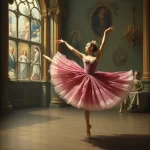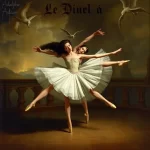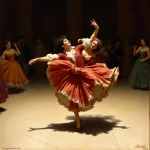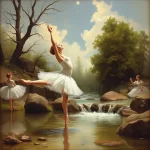Ballet: Sleeping Beauty (Pyotr Ilyich Tchaikovsky, 1890)

Introduction
Ballet: Sleeping Beauty, composed by Pyotr Ilyich Tchaikovsky in 1890, is one of the most celebrated and enduring works in the classical ballet repertoire. Choreographed by Marius Petipa, the ballet premiered on January 15, 1890, at the Mariinsky Theatre in St. Petersburg, Russia. The ballet is based on Charles Perrault’s fairy tale “La Belle au bois dormant” and tells the story of Princess Aurora, who is cursed by the evil fairy Carabosse to fall into a deep sleep for 100 years, only to be awakened by the kiss of a prince.
Historical Background
Creation and Development
The creation of Sleeping Beauty occurred during a period of significant cultural and artistic development in Russia. The late 19th century was a time when Russian ballet was flourishing, and the Imperial Ballet was at the forefront of this movement. The collaboration between Tchaikovsky and Petipa was a result of the Imperial Theatres’ director Ivan Vsevolozhsky’s vision to create a grand ballet that would showcase the talents of the company and elevate the art form.
The inspiration for the ballet came from Charles Perrault’s 1697 fairy tale “La Belle au bois dormant.” Vsevolozhsky adapted the story for the ballet, adding elements from other fairy tales and folklore to create a rich and enchanting narrative. The collaboration between Tchaikovsky, Petipa, and Vsevolozhsky was marked by meticulous planning and attention to detail, resulting in a work that seamlessly blended music, dance, and storytelling.
Premiere and Reception
Sleeping Beauty premiered on January 15, 1890, at the Mariinsky Theatre in St. Petersburg. The initial reception was mixed, with some critics praising the ballet’s grandeur and others finding it overly elaborate. However, the audience response was generally positive, and the ballet quickly gained popularity. Notable early performances included those by the original cast, featuring Carlotta Brianza as Princess Aurora and Pavel Gerdt as Prince Désiré.
Synopsis of the Ballet
Act I Summary
Act I, titled “The Christening,” introduces the main characters and sets the stage for the central conflict. The court of King Florestan XXIV is celebrating the christening of Princess Aurora. The fairies of the kingdom are invited to bestow gifts upon the princess, but the evil fairy Carabosse, who was not invited, arrives and curses Aurora. Carabosse declares that on her sixteenth birthday, Aurora will prick her finger on a spindle and die. The Lilac Fairy intervenes, altering the curse so that Aurora will not die but fall into a deep sleep, only to be awakened by a prince’s kiss.
Act II Summary
Act II, titled “The Vision,” takes place sixteen years later. During Aurora’s birthday celebration, she pricks her finger on a spindle given to her by Carabosse in disguise and falls into a deep sleep. The court also falls asleep, and a dense forest grows around the castle. One hundred years later, Prince Désiré is hunting in the forest and encounters the Lilac Fairy, who shows him a vision of Aurora. Enchanted by her beauty, the prince follows the Lilac Fairy to the castle, where he battles Carabosse and awakens Aurora with a kiss.
Act III Summary
Act III, titled “The Wedding,” celebrates the marriage of Aurora and Prince Désiré. The act features a series of divertissements, or celebratory dances, performed by various fairy tale characters, including Puss in Boots, Little Red Riding Hood, and the Bluebird. The ballet concludes with a grand pas de deux between Aurora and Désiré, symbolizing their eternal love and the triumph of good over evil.
Finale
The finale of Sleeping Beauty is a joyous celebration of love and harmony. The wedding of Aurora and Désiré signifies the resolution of the central conflict and the restoration of order to the kingdom. The ballet ends with a grand ensemble, showcasing the talents of the entire company and leaving the audience with a sense of wonder and enchantment.
Musical Composition
Composer’s Role
Pyotr Ilyich Tchaikovsky, one of the most renowned composers of the Romantic era, played a crucial role in the creation of Sleeping Beauty. His score for the ballet is considered one of his finest works, characterized by its rich orchestration, memorable melodies, and emotional depth. Tchaikovsky’s music enhances the narrative and brings the characters and scenes to life, making it an integral part of the ballet’s success.
Musical Themes and Motifs
Sleeping Beauty features several recurring musical themes and leitmotifs that represent different characters and emotions. For example, the “Garland Waltz” is a joyful and celebratory theme associated with Aurora’s birthday, while the “Rose Adagio” is a lyrical and romantic theme that underscores Aurora’s beauty and grace. Tchaikovsky’s use of leitmotifs helps to create a cohesive and immersive musical experience that enhances the storytelling and emotional impact of the ballet.
Famous Recordings and Performances
There have been many iconic recordings and performances of Tchaikovsky’s Sleeping Beauty over the years. Notable recordings include those conducted by renowned maestros such as Valery Gergiev and André Previn. Famous performances have been staged by prestigious ballet companies, including the Royal Ballet, the Bolshoi Ballet, and the Mariinsky Ballet, featuring legendary dancers such as Margot Fonteyn, Rudolf Nureyev, and Svetlana Zakharova.
Choreography and Dance
Choreographer’s Vision
Marius Petipa, the choreographer of Sleeping Beauty, is considered one of the greatest ballet masters of all time. His vision for the ballet was to create a grand and opulent production that would showcase the technical prowess and artistry of the dancers. Petipa’s choreography is characterized by its precision, elegance, and complexity, with intricate patterns and formations that highlight the beauty of classical ballet.
Signature Dance Numbers
Sleeping Beauty features several signature dance numbers that have become iconic in the world of ballet. The “Rose Adagio,” performed by Aurora in Act I, is one of the most challenging and celebrated solos in the ballet repertoire. The “Bluebird Pas de Deux” in Act III is another highlight, showcasing the virtuosity and grace of the dancers. These dance numbers not only reflect the story and characters but also demonstrate the technical brilliance and artistry of the performers.
Notable Interpretations
Over the years, different productions of Sleeping Beauty have interpreted and adapted Petipa’s choreography in various ways. Some productions have stayed true to the original choreography, while others have introduced new elements and innovations. Notable interpretations include those by George Balanchine, who created a condensed version of the ballet for the New York City Ballet, and Rudolf Nureyev, who added his own choreographic touches to the production for the Paris Opera Ballet.
Characters and Roles
Main Characters
- Princess Aurora: The protagonist of the ballet, Aurora is a beautiful and graceful princess who is cursed by Carabosse to fall into a deep sleep. She is eventually awakened by Prince Désiré’s kiss.
- Prince Désiré: The hero of the story, Prince Désiré is a noble and courageous prince who falls in love with Aurora and rescues her from the curse.
- Carabosse: The antagonist of the ballet, Carabosse is an evil fairy who curses Aurora out of spite for not being invited to her christening.
- The Lilac Fairy: A benevolent fairy who protects Aurora and helps Prince Désiré defeat Carabosse and break the curse.
Supporting Characters
- King Florestan XXIV: Aurora’s father, who rules the kingdom and hosts the christening celebration.
- Queen: Aurora’s mother, who is devastated by Carabosse’s curse.
- Fairy Godmothers: A group of fairies who bestow gifts upon Aurora at her christening and assist in the battle against Carabosse.
- Various Fairy Tale Characters: Characters such as Puss in Boots, Little Red Riding Hood, and the Bluebird, who perform divertissements at Aurora and Désiré’s wedding.
Famous Dancers
Many renowned dancers have portrayed the roles in Sleeping Beauty over the years. Carlotta Brianza, the original Aurora, set a high standard for future ballerinas. Margot Fonteyn and Rudolf Nureyev’s performances as Aurora and Désiré are legendary, as are those of more recent stars like Svetlana Zakharova and Roberto Bolle.
Cultural and Artistic Impact
Influence on Ballet and Dance
Sleeping Beauty has had a profound influence on the world of ballet and dance. Its grand scale, intricate choreography, and beautiful music have set a benchmark for classical ballet productions. The ballet has inspired countless choreographers, dancers, and composers, and its themes of love, good versus evil, and the triumph of beauty and grace continue to resonate with audiences.
Cultural Significance
Beyond its impact on ballet, Sleeping Beauty has become a cultural touchstone, referenced in literature, film, and other media. The story of Aurora and her enchanted sleep has been adapted into various forms, including Disney’s animated film “Sleeping Beauty” and numerous stage and screen adaptations. The ballet’s themes and imagery have also influenced fashion, art, and popular culture.
Legacy and Revivals
Sleeping Beauty continues to be performed and celebrated around the world. Major revivals by companies such as the Royal Ballet, the Bolshoi Ballet, and the Mariinsky Ballet have kept the ballet alive for new generations of audiences. Modern adaptations and reinterpretations have also brought fresh perspectives to the classic work, ensuring its enduring legacy in the world of dance.
Iconic Productions
Historic Productions
Some of the most famous historical productions of Sleeping Beauty include the original 1890 premiere at the Mariinsky Theatre, the 1921 Diaghilev production in London, and the 1946 Royal Ballet production at Covent Garden. These productions featured key figures such as Carlotta Brianza, Sergei Diaghilev, and Margot Fonteyn, who played pivotal roles in bringing the ballet to life.
Contemporary Productions
Recent productions of Sleeping Beauty have continued to captivate audiences with their innovative approaches and high production values. Companies like the American Ballet Theatre, the Paris Opera Ballet, and the Australian Ballet have staged acclaimed performances that blend traditional choreography with modern elements. These contemporary productions often feature cutting-edge set, costume, and lighting design, adding new dimensions to the classic ballet.
Production Design
The production design of Sleeping Beauty plays a crucial role in creating the magical and enchanting world of the ballet. Set designs often include elaborate castles, lush forests, and opulent ballrooms, while costumes range from regal court attire to fantastical fairy outfits. Lighting design enhances the mood and atmosphere of each scene, from the bright and celebratory christening to the dark and mysterious forest.
Critical Reception and Reviews
Initial Critical Response
At the time of its premiere, Sleeping Beauty received mixed reviews from critics. Some praised the ballet’s grandeur and Tchaikovsky’s music, while others found it overly elaborate and lengthy. However, the audience response was generally positive, and the ballet quickly gained popularity, becoming a staple of the classical ballet repertoire.
Modern Reviews
Contemporary critics and audiences continue to hold Sleeping Beauty in high regard. The ballet is often praised for its beautiful music, intricate choreography, and timeless story. Modern productions are frequently lauded for their innovative approaches and high production values, ensuring that Sleeping Beauty remains relevant and beloved by audiences around the world.
Fun Facts and Trivia
Behind-the-Scenes Stories
One interesting behind-the-scenes story involves the original production’s elaborate sets and costumes, which were designed by Ivan Vsevolozhsky himself. The production was so lavish that it reportedly cost more than any other ballet produced at the time. Another anecdote involves Tchaikovsky’s initial reluctance to compose the score, as he was unsure if he could match the success of his previous ballet, Swan Lake. However, he ultimately created one of his most celebrated works.
Notable Performers
Over the years, many famous dancers, conductors, and directors have been associated with Sleeping Beauty. Notable performers include Margot Fonteyn, Rudolf Nureyev, Svetlana Zakharova, and Roberto Bolle. Renowned conductors such as Valery Gergiev and André Previn have also contributed to iconic recordings of the ballet’s music.
Trivia
- Sleeping Beauty was Tchaikovsky’s second ballet, following Swan Lake and preceding The Nutcracker.
- The “Rose Adagio” is considered one of the most challenging solos in the ballet repertoire due to its demanding balance and technical precision.
- The character of Carabosse is often portrayed by a male dancer in drag, adding a unique theatrical element to the role.
Conclusion
Summary of the Ballet’s Importance
Sleeping Beauty is a cornerstone of the classical ballet repertoire, celebrated for its beautiful music, intricate choreography, and timeless story. The collaboration between Tchaikovsky and Petipa resulted in a work that has captivated audiences for over a century and continues to inspire dancers, choreographers, and composers.
Final Thoughts
Sleeping Beauty remains a testament to the power of collaboration and artistic vision. Its enduring popularity is a testament to its universal themes of love, good versus evil, and the triumph of beauty and grace. Whether you are a seasoned ballet enthusiast or a newcomer to the art form, experiencing a performance of Sleeping Beauty is a magical and unforgettable experience.
FAQ
What is the central theme of this ballet?
The central theme of Sleeping Beauty is the triumph of good over evil, as well as the power of love and beauty to overcome adversity.
Who are the main characters in this ballet?
The main characters are Princess Aurora, Prince Désiré, the evil fairy Carabosse, and the benevolent Lilac Fairy.
What is the most famous dance number in this ballet?
The “Rose Adagio,” performed by Aurora in Act I, is one of the most famous and challenging dance numbers in the ballet.
How long does a typical performance of this ballet last?
A typical performance of Sleeping Beauty lasts approximately three hours, including intermissions.
Are there any modern adaptations of this ballet?
Yes, there have been numerous modern adaptations and reinterpretations of Sleeping Beauty, including condensed versions, contemporary productions, and adaptations in film and other media.
Why is this ballet considered important in the history of dance?
Sleeping Beauty is considered important in the history of dance due to its grand scale, intricate choreography, and beautiful music. It has set a benchmark for classical ballet productions and continues to inspire and influence the world of dance.





